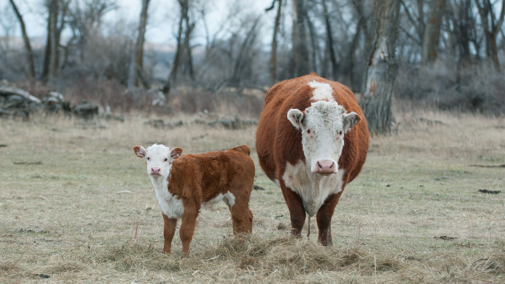High Quality Hay After Calving
Good cow nutrition is crucial following calving to get cows rebred. Today, let's look at the reason for using our top tier hay after calves hit the ground.
Because cows experience a lot of stress after calving, they need good feed. Not only is the cow producing milk for her calf, she is also preparing her reproductive system to rebreed. As a result, nutrient demands are high. Energy requirements increase about 30% and protein needs nearly double after calving. Underfeeding reduces the amount of milk a cow provides her calf, and it can delay or even prevent rebreeding. If it gets cold, wet or icy again, nutrient demands can skyrocket.
Even if animals can get to them, winter grass, cornstalks and other crop residues are low quality right now since these feeds have weathered and are well picked over. Therefore, it is critical that the hay or silage you feed will provide the extra nutrients your cows need.
Because of this, not just any hay or silage will do. After calving a cow needs 10% to 12% crude protein and 60% to 65% TDN in her total diet. If she is grazing poor quality feeds or eating grass hay, your other forages and supplements must make up any deficiencies.
Make sure your forage has adequate nutrients; if you haven't done so yet, get it tested now for protein and energy content. Compare this to the nutrient requirements of your cows. Then feed your cows a ration that will meet their requirements. Use supplements if needed, but don't overfeed, either.
Calving and the months after are a stressful time for cows. If we underfeed, it can delay rebreeding and slow down calf growth. Use your best quality forages with any needed supplements to provide adequate nutrition. By meeting nutrient requirements, your cows will milk well, rebreed on time, and produce healthy calves year after year.
Frost Seeding or Interseeding Legumes
Are you looking to increase production from pastures or hay fields? Frost seeding or interseeding legumes might just work in your operation.
Nitrogen is one of the key ingredients for productive pastures. A way to get more nitrogen in a pasture is to plant legumes. Alfalfa, clovers, birdsfoot trefoil and other legumes all fix atmospheric nitrogen and can reduce nitrogen costs. These legumes are also very high in forage quality.
Not all pastures are good candidates for adding legumes, however. First, legumes need adequate phosphorus and a pH usually above six, while some prefer a pH closer to seven. Frost seeding is a method where legume seed is simply broadcast in winter to allow the natural freezing and thawing of the ground to plant the seed for you. Because frost seeding requires seed to be close to the soil surface after broadcasting, snow-free or very little snow is preferred. Frost seeding success can vary and while frost seeding is easier to do, drilling is almost always a better option if the pasture conditions allow it. Interseeding with a no-till drill better ensures seed placement and seed to soil contact.
Lastly, heavy flash grazing several times in the spring will reduce the competition from existing grasses and help establishment of legume seedlings. Once the grass is three to four inches taller than the seedlings, graze quickly until the grass is grazed down to the height of the legume seedlings.
Legumes can help reduce fertilizer cost and create higher quality pastures and hay. Frost seeding or no-till drill interseeding are two approaches that might work to establish legumes in your operation.

